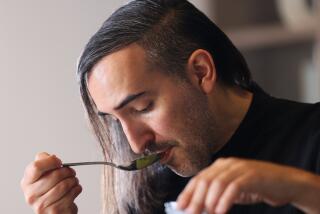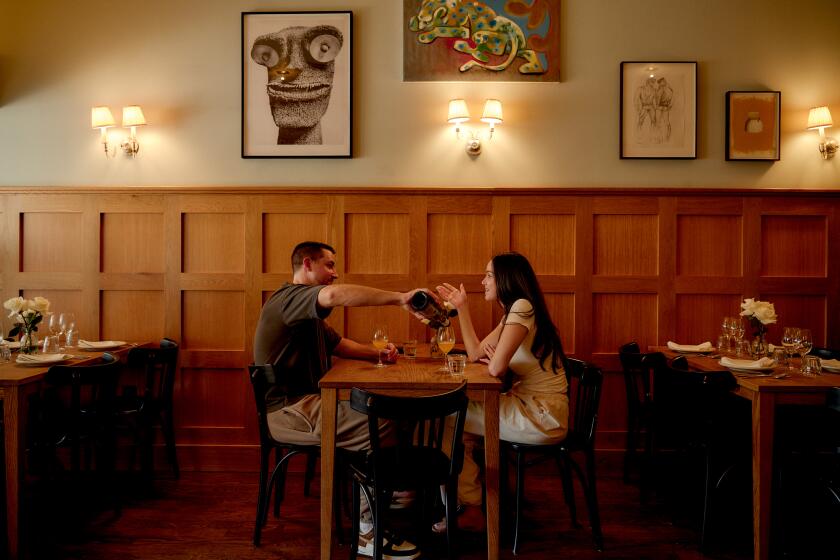The Time of Food : The Melting Pot of the Future
“I was just in the Northern California hop fields,” says Raymond Sokolov in the genial, musing tone that seems to come naturally to him. “After they gather the hop blossoms, they dry them out on a heated floor. They do batch after batch, and as they go they shovel the dried flowers into a storage room for baling.
“And if you fall into that room, you die. You drown in this loose, shifting sea of dried flowers. It’s like quicksand, only you’re fighting the disorienting aroma of hops as well.
“Somebody up there told me, ‘We’ve had a couple of guys fall in over the years. We saved one. Nothing was showing of him but his finger, so I stuck in a long pole and he grabbed it.’
“I don’t know why he told me that. He knew a journalist couldn’t help repeating it. I’m telling everybody.”
He sure is, and not only when he thinks he is. The people at the next table have been pricking up their ears. One of them has clearly decided never to become a hop handler, and the other looks as if she might never order beer again, at least not in this particular Santa Monica cafe.
But telling interesting tales is what Raymond Sokolov does, in his columns in Natural History and the Wall Street Journal and his books, most of which have had food angles. His latest, “Why We Eat What We Eat” (Summit Books), is full of tales about food history.
In the ‘70s, like most foodies of the time, Sokolov pursued a holy grail called “authenticity.” Back then he wrote a book (“Fading Feast: A Compendium of Disappearing Regional American Foods”) documenting our local cuisines and food-ways, which he saw disappearing under the influence of commercialism and mass communication.
He noticed that culinary regionalism had always resulted when pioneers adopted local American ingredients. “These new foods and new cuisines,” he says, “sprang up almost overnight in the freedom of the frontier, before the comforts of the home culture had time to arrive and eliminate the need for improvisation. And when those comforts did arrive, innovation ceased and most of the new recipes became mere regional oddities.
“In every section there was a brief moment of precarious originality. The creative period in American regional cuisine was always a period of clashing cultures, where the pioneers had to adopt local ingredients to survive. In Indiana, for instance, they created a lot of dishes featuring persimmons.”
His new book is subtitled “How the Encounter Between the New World and the Old Changed the Way Everyone on the Planet Eats.” It sounds like something pegged to the 500th anniversary of Columbus and to his publisher it may be, but to Sokolov it’s an outgrowth of “Fading Feast.” From our pioneers’ adoption of New World ingredients in this country, he had gone on to wonder about the reception of New World ingredients in Europe.
There, he says, he found something unexpected. European regional cuisines--the prime goal of the authenticity quest of the ‘70s--have practically as short a history as our own.
“The well-known national cuisines of Europe,” he says, “turn out to have only developed in the last 200 years or so, largely on the basis of foods from the New World. In the Middle Ages, aristocrats in one European country ate a lot like aristocrats in another, and European peasants ate much the same wherever they were too, largely bread and porridge.
“I see the regional cuisines as deriving from the development of nationalism and national feeling. The extreme regionalism of Italian food corresponds to the fragmented political situation there, the sense of a single French cuisine to the strong centralizing tendencies of France under the absolute monarchs.”
Sokolov is particularly interested in dishes that mix Old World and New World ingredients and techniques. New England Indian pudding, for instance, which is made with American corn, European rye flour and molasses, a by-product of the Caribbean slave trade. He sees this sort of thing as the wave of the future.
After 1981, he points out, every trendy restaurant in the country began flaunting regional dishes and ingredients: “People I had interviewed (for “Fading Feast”) in the ultimate boondocks of the country in order to record the death of the regionalism they still were preserving turned up in food-page articles as purveyors of luxury specialties to Manhattan and Los Angeles restaurants.”
In “Why We Eat What We Eat,” Sokolov reports how new chefs around the world, from Lyons to Manila, are “stirring this global melting pot.” Or, as he puts it in slightly self-mocking academic jargon, “hatching idiocuisines in a notional frontier” made possible by jet transport and refrigeration. For the book he visited a Mexico City restaurant that specializes in pre-Columbian ingredients, but cooked in post-Columbian ways, and a Manila restaurant where balut (unhatched baby chick, a Philippine specialty) is served in puff pastry.
“Most food writers dismiss this kind of cross-cultural hybridization as decadent,” he writes in the book, “but they miss the point, just as the whole world missed the point the first time around during the original Columbian food revolution.”
He suspects the ultimate results of the global experimentation going on now will be as profound as the wave of rapid change in eating habits that went on in the 16th Century, with results impossible to foresee. “Cuisines evolve almost instantly when two cultures and their ingredients meet in the kitchen,” he says, “and old cuisines never die.”
More to Read
Eat your way across L.A.
Get our weekly Tasting Notes newsletter for reviews, news and more.
You may occasionally receive promotional content from the Los Angeles Times.










